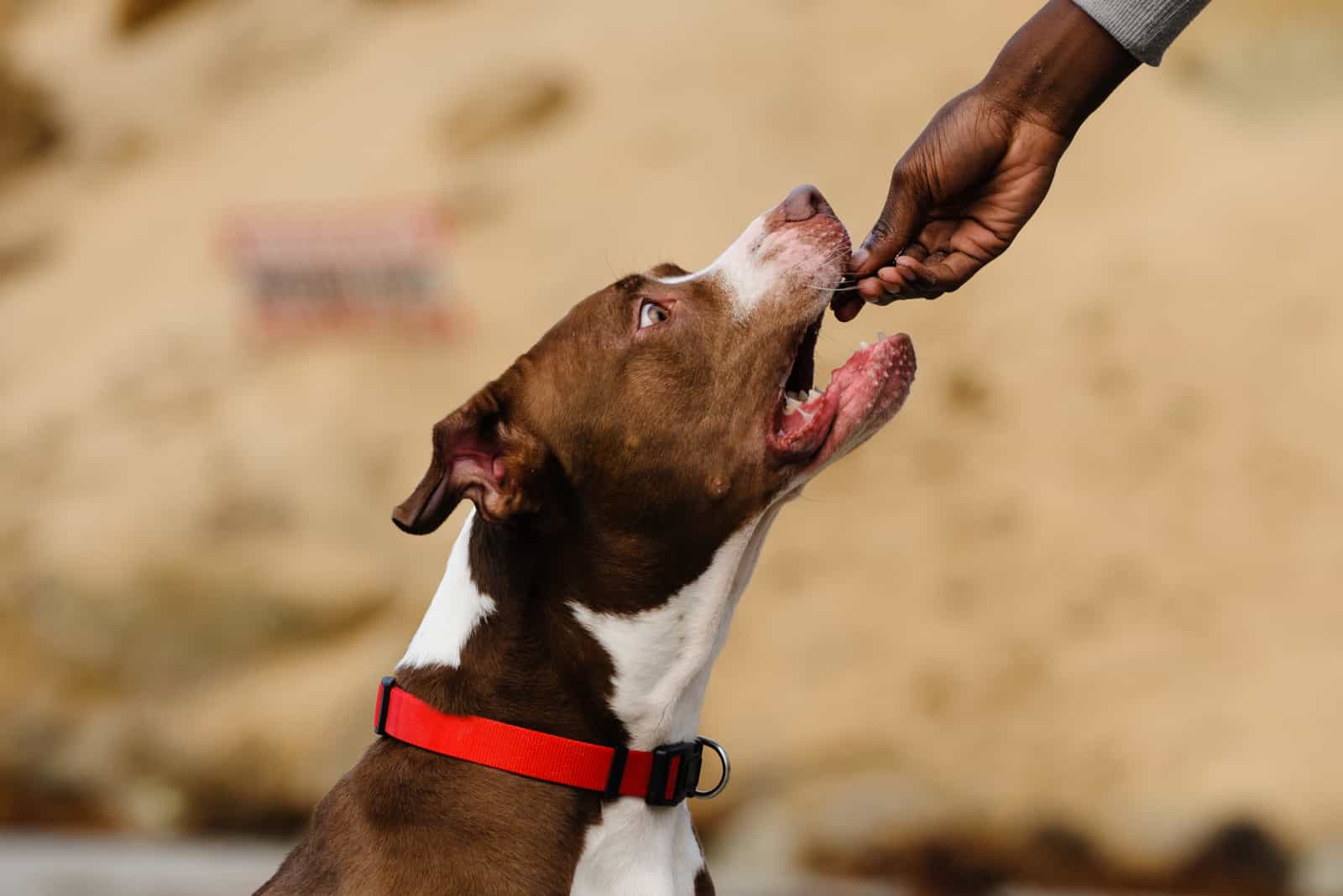The Pitbull raw diet is a very interesting topic, and if you are a Pitbull owner, you must have thought about feeding your dog raw food at some point.
Raw food has its pros and cons, and there are people on both sides of the fence, arguing which is better. Some dog owners claim that it’s healthier, more natural, and that it makes their pets happier, while others will say that there are many risks associated with it.
In this article, we will go into extensive detail about the raw diet itself, how suited it is for Pitbulls and Terriers in general, and — if you stick around to the end — we will be giving you a few easy-to-make recipes.
So, let’s get stuck into it!
What Is A Pitbull Raw Diet?
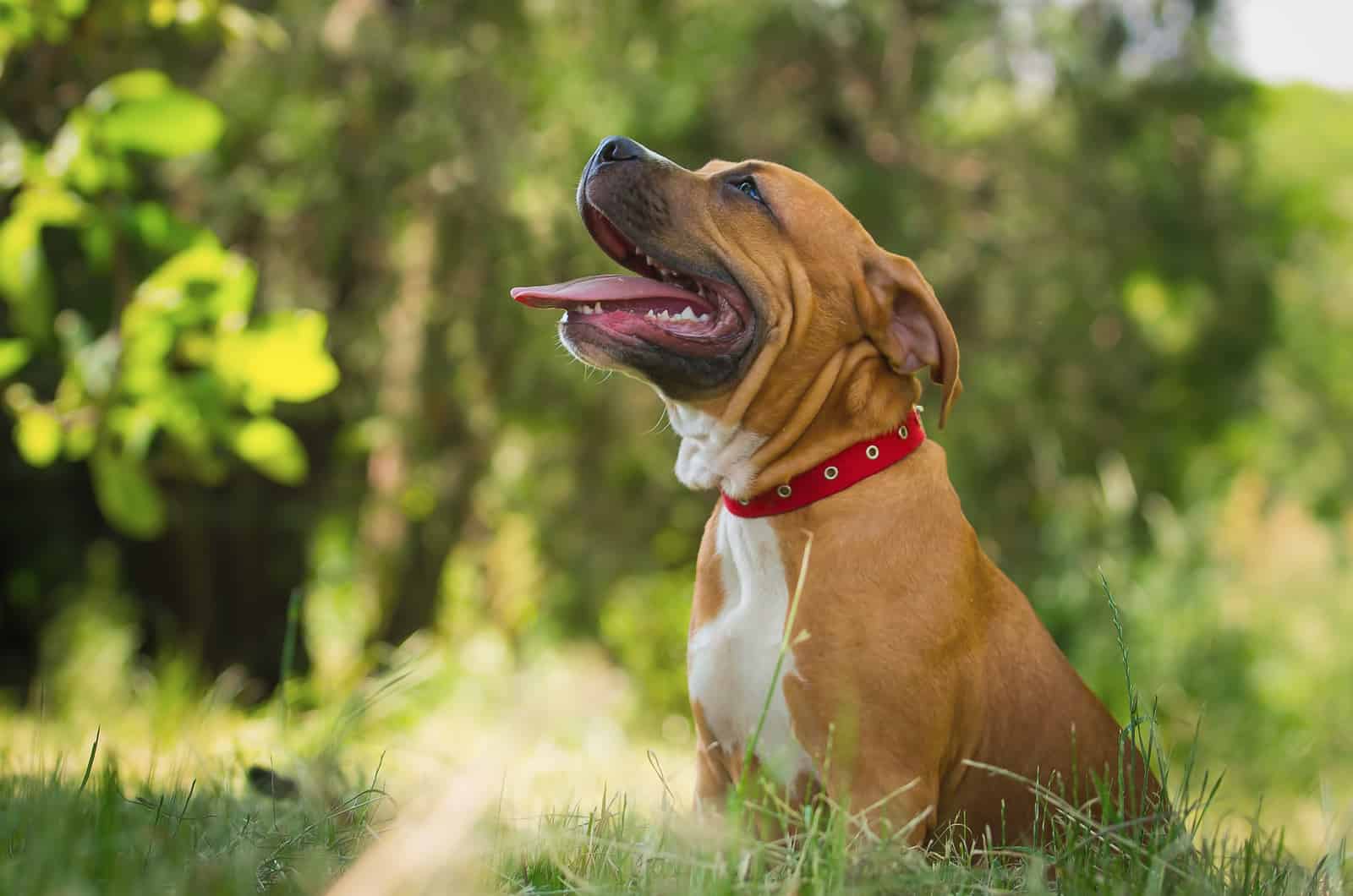
The raw diet has become increasingly popular in recent times. It is an attempt to create an alternative to commercial dog food by bringing back all the natural, raw, ingredients that dogs ate in the wild.
Commercial pet foods, whether it’s wet or dry dog food, come in a wide variety of brands and prices. Some products are high-quality and very nutritious, and some of them are even human-grade.
However, others can be nothing but empty calories, and navigating between these in order to choose the right food for your Pitbull can be a hassle.
But, there is one thing that is common with both the most expensive, top-shelf dog food brands, and the cheap stuff. They are all heavily processed. The ingredients that they use go through a lot before they end up forming those little pellets of kibble that we are so familiar with.
That is one of the main arguments used in the raw food vs. kibble debate that supporters use against conventional dog food. By choosing raw food instead, you know that you are using completely natural, unprocessed ingredients.
But, how solid is that argument? And, more importantly, how good is a raw homemade diet for Pitbulls in particular? Let’s discuss.
What is BARF?
BARF is an acronym that stands for two things, both of which have the same essence, really. Whether you choose to interpret it as “Bones And Raw Food” or “Biologically Appropriate Raw Food”, it carries the same meaning.
It was first coined by Ian Billinghurst, an Australian vet, back in 1993. He believed that before dogs became domesticated, they ate a diet consisting exclusively of raw meat, bones, and greens that they could find in the wild.
He thought that commercial dog food was far away from this natural state, and that dogs should be reintroduced to a BARF diet.
Is A Raw Diet Good For Pitbulls?
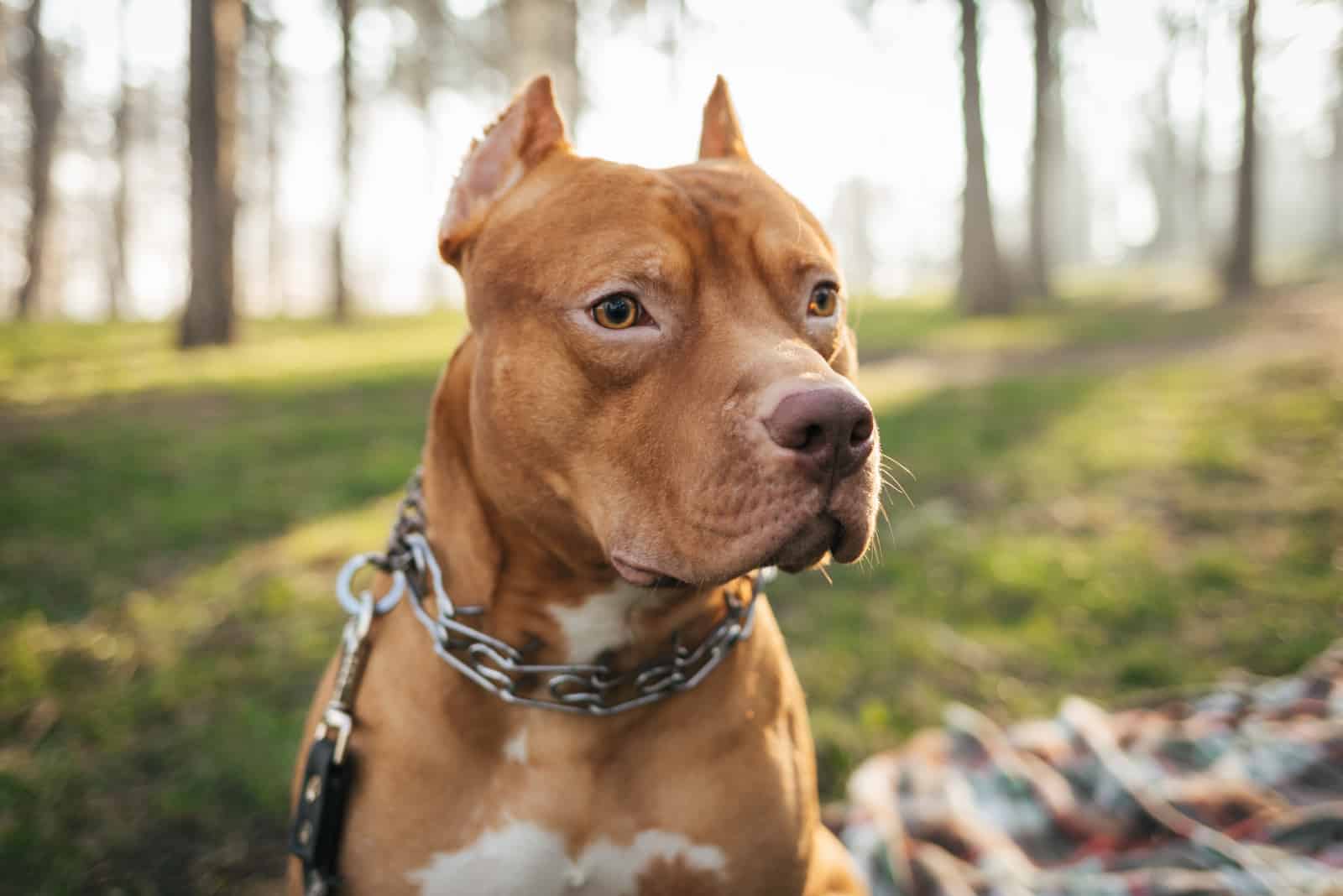
There is no definitive answer to this question. As we said, there are valid arguments for both sides, and it is up to you as the owner to make the decision.
However, whichever decision you might end up making, it is crucial that it’s a well-informed one, and backed by scientific facts.
One of the biggest risks involved in people creating raw-meat diets for their Pitbulls is either doing it entirely on their own or following some online instructions. Needless to say, the internet isn’t always right.
It’s important that you do the necessary research, check with reputable sources, and most importantly, have a conversation with your vet. No online source can ever give you advice that is pertinent and specific to you as the person who knows your dog and its health background.
With this article, we hope to bring you some important facts that might make the issue clearer for you. That’s why we will be presenting both the pros and the cons of the Pitbull raw diet.
What Are The Benefits Of A Raw Diet?
Because of their high activity levels, Pitbulls burn a lot of energy during the day, and therefore, they need a lot of protein and a generally high caloric intake. They usually spend about 2,000 calories of energy via their activities, so to compensate for that, they need a lot of food.
Aside from having a high energy value, there are other possible health benefits that stem from switching your Pitbull to a fully raw diet.
A Healthier Coat
Raw food is known to have a big positive impact on a dog’s skin and coat. Pitbulls have a very short coat, and they don’t shed a lot, but they still have some grooming needs.
However, by getting them the proper nutrients from raw food, you will start noticing that they will be getting a smoother and shinier coat over time. This is because all the healthy fats and proteins strengthen the skin and the hair follicles attached to it.
There are also studies out there that suggest that introducing raw food to puppies can lead to a boost in their immune system, as well as a decrease in skin-related allergies.
Cleaner Teeth
This perhaps might seem counter-intuitive, but it’s actually one of the best-known benefits of eating exclusively raw food.
Kibble can take its toll on a dog’s teeth. All the different sugars and carbohydrates in it can, with enough time, start forming plaque and various residues. This can be treated by taking special care of your dog’s dental hygiene, but it can also be largely avoided by switching to a raw dog food diet.
Raw food is unprocessed, which means it doesn’t have any synthetic sugars or any other filler. In addition to that, it is full of natural enzymes that protect a dog’s teeth and gums. It prevents tooth decay, and makes your Pit’s breath smell much better!
Muscle Development
Pitbulls are one of the most iconic dog breeds out there, and a massive part of their reputation is their muscular build. They are always thought of as strong, handsome, and squarely-framed dogs.
However, like many mixed breeds, they are more susceptible to weight gain than most dogs. Feeding them unhealthy and sugary food can result in them gaining extra pounds, which will put a lot of pressure on their joints.
Not only will they lose their trademark muscular look, but they can also experience joint problems. Feeding them lean, raw meat that is rich in protein, as well as vegetables that bring them vitamins, fibers, and healthy fats will avoid rapid weight gain.
Simply put – giving them lean food will help them stay lean.
Higher Energy Levels
We already mentioned the correlation between raw food and energy, but let’s explain it a little better here.
All the fillers and by-products that are regularly found in pet food can make dogs a bit more inert and sluggish than they are supposed to be. Since Pitbulls are such an active breed, this could be a problem for them.
Raw food contains proteins, healthy fats, and fatty acids that will replenish your Pitbull’s energy reserves, and allow him to remain playful throughout the day.
And, as we know… physical activity and exercise are some of the main factors of a dog’s health, so there can be positive consequences in the long run if you introduce raw food into their diet.
Improved Bowel Movement
Raw food tends to have a higher fiber content than conventional dog food that you buy in the store. This is especially true with some veggies such as carrots, green beans, lettuce, kelp, etc.
Fiber, of course, is the main factor in keeping a dog’s poop regular, firm, and healthy. Regular bowel movements are a sign of metabolism that is working well, and that is usually a reflection of good overall health.
If you think that your dog poops too much and you don’t know why, maybe you should consider switching to raw food.
What Are The Downsides Of A Raw Diet?
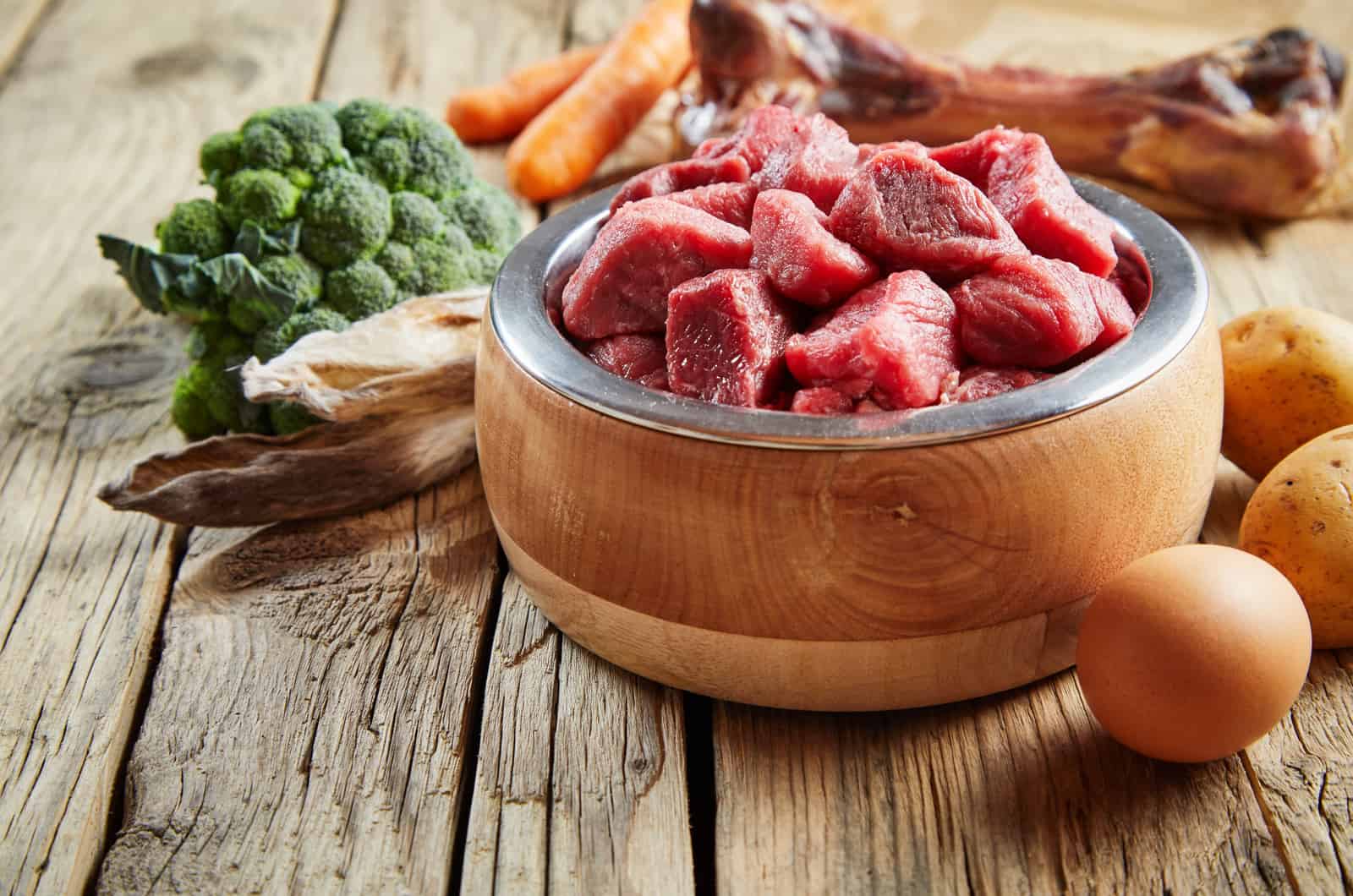
After listing and detailing all the potential positives of a Pitbull’s raw diet, it’s only fair that we go through some of the negatives as well.
A raw diet is not perfect, and it carries some potential risks, particularly if you don’t put in all the necessary effort to make sure that the food is properly sourced, stored, and prepared. Knowing all the dangers is essential if you are considering switching your Pitbull to a raw food diet.
Bacteria In Raw Meat
This is the most obvious risk. Everyone knows that raw meat is extremely susceptible to having various bacteria cultures growing on it. Some of them can be dangerous to not only dogs that are eating the meat, but also humans who are handling it.
To make sure that your raw meat is bacteria-free, you need to take all the necessary precautions. Here are some key pieces of advice that you should always stick to.
Buy Meat Only From Trusted Sources
Do a little research before you choose the butcher or the shop that you will be buying your meat from. Make sure that they are reputable, well-respected, and that they have a great track record.
Only buy meat that you would be comfortable eating yourself.
Wash It Carefully
One of the best things about cooking is that it kills most of the bacteria and other harmful organisms that can live on the meat.
However, there is no cooking involved in a raw diet, so you need to do the absolute best you can to clean the meat yourself. Give it a thorough wash, and inspect it carefully to see if there is anything suspicious on it.
Freeze The Meat Properly
This is probably the most important step in all of this, and it is where a lot of people make their mistakes.
Meat should be kept at a temperature of 0 degrees Fahrenheit (-18 degrees Celsius) or lower, and it should never under any circumstances be re-frozen. Once it has been taken out of the freezer and exposed to external elements, it needs to be either eaten by your dog or thrown away.
Meat that has not been frozen properly is a breeding ground for salmonella, listeria, E. coli, and a whole host of other harmful bacteria that could cause massive health problems to your dog and to yourself.
Don’t Buy Too Much At Once
This one is kind of related to the previous one. If you buy more meat than your Pitbull needs in a week or two, chances are that some of it will be stored for too long and end up spoiling.
Figure out how much meat your dog needs in a week, and don’t buy any more than that. Not only will you risk spoiling some of it, but it’s also just a waste of money.
High Fat Content
After delving deep into all the risks associated with bacteria living in the meat, it’s time to talk about some of the other downsides of raw food.
The main part of any raw diet will certainly be meat, but not all meats are created the same. Some types of meat like beef, lamb, and pork have a ton of fat in them, and they can make your dog quickly add body weight.
We talked about lower chances of obesity as one of the benefits of a raw diet, so it’s important not to undo all that by feeding your dog a lot of fatty meat.
It’s best to stick to the leaner stuff like chicken or turkey. Be sure to remove the skin as well as it has a higher level of fat.
Possible Choking Hazard
This one might not be as obvious as some of the others, but it’s just as important.
A part of feeding raw food to your dog can involve giving them bones. And, if there’s one thing that everybody knows about dogs, it’s that they love bones.
But, you need to be careful with them. If the bones are too small, they can get stuck in the dog’s throat or even pierce their esophagus or intestines.
Furthermore, bigger bones can splinter into small pieces, or be a struggle to break down for some dogs. Dogs might even risk hurting or breaking their teeth in the process.
When feeding bones to your dog, it might be best to grind them down first, and mix them into their meal.
Unbalanced Diet
We are using the term “unbalanced diet” here as a catch-all to describe all the mistakes that dog owners can make when planning and preparing a raw diet for their Pitbull.
Dog food that you buy in the pet store always has its full nutritional facts listed on the packaging. This is a very useful thing as it lets you know exactly which nutrients and how much of them your dog is getting.
These are formulated by experts in high-budget facilities, with resources that you simply don’t have. When you’re making the meals yourself, it’s very difficult to know the exact nutritional value of each serving.
Over the course of time, this can lead to your dog not getting enough of certain important nutrients, or perhaps getting much more than they actually need.
To avoid this, your best bet is to find highly reputable sources of recipes, with a proven track record. Pay close attention to their measurements, and don’t deviate from the instructions. Don’t treat raw dog food like human food, where you can experiment with spices and stuff.
If you’re not sure that you can provide all the nutritional value to your dog by making homemade raw meals, you can always stick to regular dog food. There are many products out there that are specifically made for Pitbulls, so with some research, you should be able to find something.
What Raw Foods Can Pitbulls Eat?
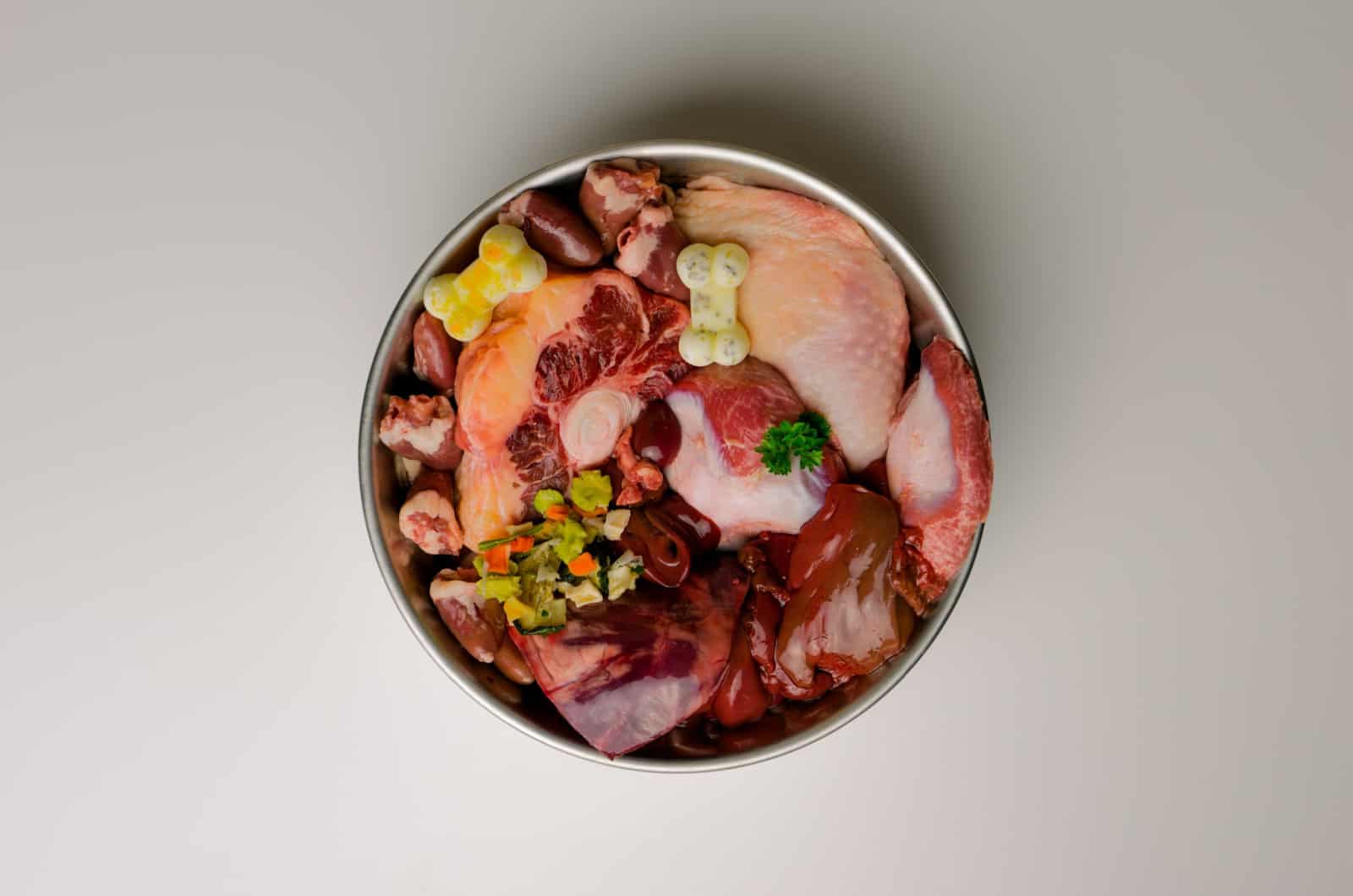
After deciding to switch your Pitbull to a completely raw diet, it’s important that you have a group of base ingredients that you can always rely on and use in the meals you make.
In this section of the article, we are going to list some of the most commonly used ones, and explain why each of them is important.
Raw Meat
Meat is the basis for any dog meal plan. It is the part of the diet that brings in the most calories and nutrients. Getting this part right is essential for providing a healthy diet to your pooch.
There are many meat products that you can choose from, and we’ve divided them into four different categories: meaty bones, organ meat, muscle meat, and fish.
So, if you’re asking yourself how much raw meat you should feed your Pitbull, here is the answer.
Raw Meaty Bones
If meat is the main part of the diet, then raw meaty bones (RMB) are the main part of that part. RMBs should comprise the bulk of your Pit’s diet, and be one of its main protein sources.
But, there is something that their body requires in order to function properly, which can’t be found in meat alone — calcium. Dogs need a certain amount of calcium to support their development and strengthen their skeleton, and they get the majority of it from animal bones.
Here are some RMBs that are good for your Pitbull:
• Poultry: chicken is the best option, but other types of bird meat such as turkey, duck, pheasant, and quail are also good.
• Rabbit: basically the entire animal, minus the intestines and the belly.
• Pork: it’s very high in fat content, but some small amounts won’t hurt. The best parts to use are the neck, ribs, and shoulders.
• Lamb: similar to pork, lamb should only be added to the diet in moderation. Focus on the neck, ribs, and breasts.
Remember to think about the potential choking hazards of tiny bone fragments. If necessary, grind down the bones and add them to the meals that way.
Raw Organ Meat
Organ meat should be the second-most represented element in a Pitbull’s raw diet. In fact, it should make up about 10% of its entire intake.
The best organs that you can give to your Pit are livers, kidneys, and hearts, preferably from chickens and turkeys.
Raw Muscle Meat
Muscle meat is a great additional source of protein and fiber, but it should only comprise a small part of your Pitbull’s diet.
About 16 to 20 ounces (450 to 570 grams) of ground boneless meat per week should be enough to complement the rest of the ingredients.
Raw Fish
Fish is an interesting one as you don’t normally associate dogs with eating a lot of it. However, its high levels of omega-fatty acids are just one of the benefits that it brings to a dog’s diet.
However, wild fish often contains parasites and dangerous pathogens, so it can be tricky to choose the right ones to feed your Pitbull. Probably, the best way of approaching this is by selecting just the fish that is approved for making sushi, but if you don’t have access to that, you can use canned tuna or sardines.
Just make sure that it doesn’t have any additives, and that you drain it completely before serving it to your dog. One fish to avoid at all costs is salmon as it carries the risk of salmon poisoning disease.
Raw Eggs
We mentioned bones as the most important source of calcium for dogs, but they are not the only ones. Eggshells are basically 95% calcium, and they act as a great counter-balance to all the phosphorus found in the meat.
You can combine eggs with the muscle meat, or just feed a whole egg (with the shell) to your Pitbull every other day. That should be enough to stock up on calcium, but it will also improve your dog’s coat health and make it smooth and shiny.
Fruits & Vegetables
Just like in human diets, fruits and vegetables are great sidekicks to meat, and they should never be overlooked.
Well, first of all, they are very rich in vitamins, minerals, and fiber. Those three nutrients are highly beneficial, and they can’t really be found in any animal-based products. So, supplementing meat as the basis of the diet with enough veggies and fruits should give a lovely balance to your dog’s nutrition.
It can be a bit of a hassle to prepare since you need to chop them up into tiny pieces (most likely by using a food processor), but they are worth the trouble if you want your Pitbull to have the best possible diet.
If you’re not sure which plants to go for, we recommend lettuce, broccoli, carrots, brussels sprouts, and zucchini, as well as pears, apples, and berries.
Supplements
We wanted to include supplements on this list, but only with the caveat that they are entirely optional. They can be a great addition to any diet because they satisfy a very specific need that you might not get with any raw food combination.
Omega-3 fish oil capsules and vitamin E pills are some of the most commonly used supplements, but always make sure to consult your vet before giving any to your Pitbull. They will know best whether your dog even needs supplements.
Pitbull Raw Food Recipes
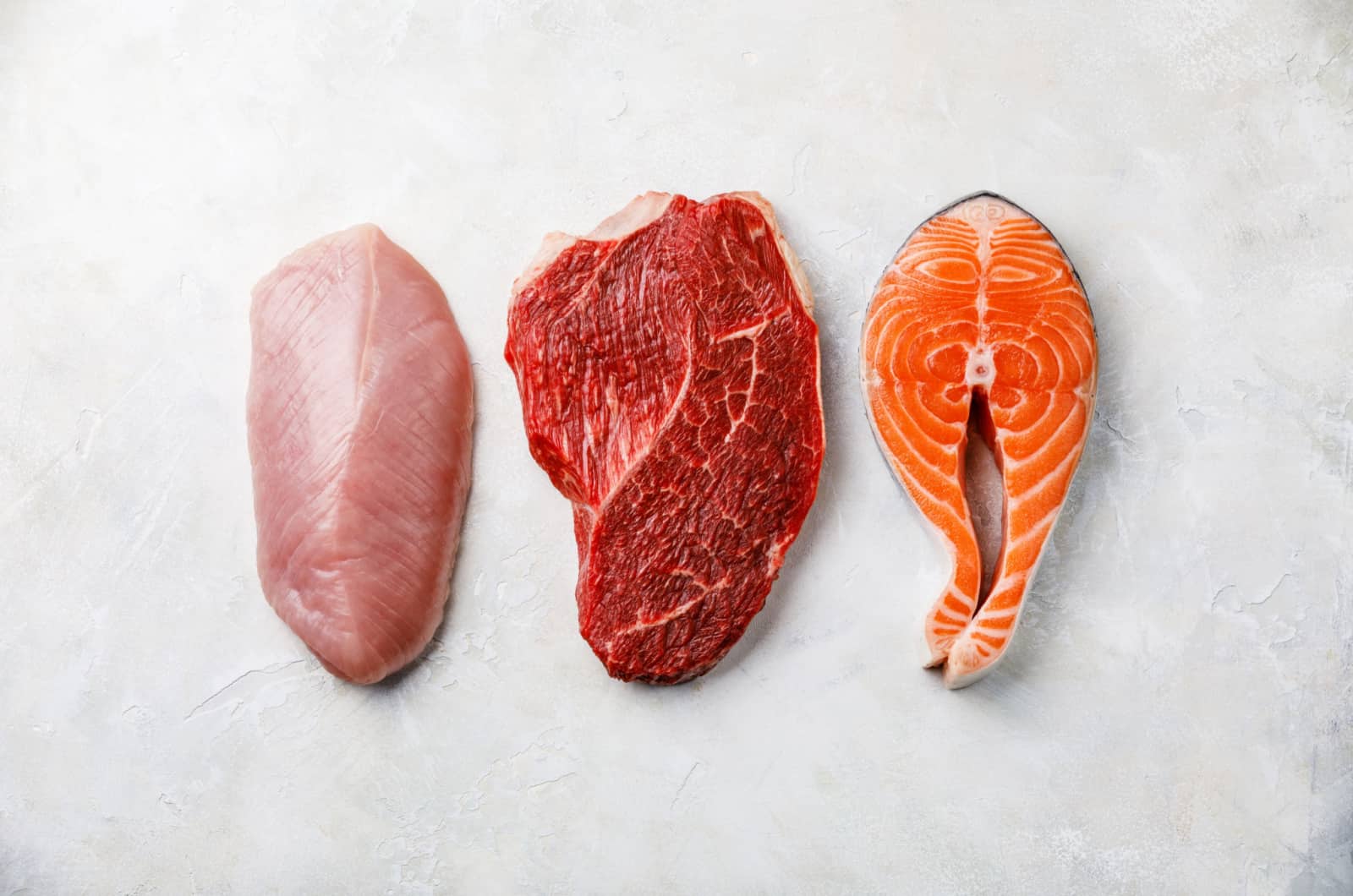
Okay, after talking about all the pros and cons of raw food, and listing all the specific foods that you can safely feed your Pitbull, it’s time for recipes!
Here are three simple, easy-to-follow recipes that can help you get started with shifting your dog to a completely raw diet. Once you’ve mastered these, you can move on to other ones that you find.
But remember… only use recipes from highly trusted sources.
Raw Boneless Turkey Recipe
This easy-to-make recipe combines turkey meat with animal organs and eggs, which makes for a delicious and nutritious raw meal for your Pitbull, whether it’s all grown up or still just a puppy.
This particular meal is free of grains, as well as any synthetic supplements and additives.
Ingredients
• 5 pounds of lean ground turkey
• 2 pounds of chicken heart
• 1 pound of beef liver
• 6 whole eggs with no shells
• 8 ounces each of three different green veggies (for example, kale, broccoli, cabbage, etc.)
• 12 ounces total of various berries (raspberries, blueberries, blackberries, etc.)
• 3 tablespoons of ground pumpkin seed powder
• 2 teaspoons of Himalayan salt
• 1/4 teaspoon of kelp
Preparation
Start with chopping up the chicken heart and beef liver into fine little pieces. You can even use a grinder if that’s easier for you.
After that, get the eggs, veggies, berries, pumpkin seed powder, salt, and kelp and mash them all together. You can even add a bit of basil if you want, but not too much!
Probably the best way to mix this is to put it all in a food processor and let the machine turn it into a nice purée.
Now, add the ground turkey and the chopped-up chicken heart and beef liver to the purée and mix it all together. Keep mixing until the texture is just right.
Once you’re done mixing, separate it into smaller portions and put them in the freezer.
Nutritional Value
Following this recipe exactly will result in about 11 pounds of dog food, which is roughly a week’s supply for a 50-pound dog. When it comes to puppies, it’s a little trickier to figure out exactly how much raw food they’re supposed to eat.
Regarding the meal’s nutritional value, it comes out at around 520 calories per pound, which means that the whole batch will have approximately 5,700 calories.
When it comes to individual nutrients, the most represented one is protein, with about 15%, and the next one is fat, with 7%. The majority is composed of moisture, with some traces of carbs and fiber.
Raw Boneless Beef Recipe
Beef is usually a dog’s favorite, and it’s no different when it comes to Pitbulls. When prepared raw, it’s best to add some eggs and vegetables to make it more varied and fulfilling.
This next recipe will show you how to do just that! It’s very similar to the turkey recipe, so if you’ve learned to make that one, this one should be easy for you. And, it’s so tasty that it will probably make your Pitbull give it a chef’s kiss.
Ingredients
• 5 pounds of lean ground beef
• 2 pounds of beef heart
• 1 pound of beef liver
• 8 whole eggs with no shells
• 8 ounces each of three different green veggies (for example, kale, broccoli, cabbage, etc.)
• 12 ounces total of various berries (raspberries, blueberries, blackberries, etc.)
• 2 teaspoons of Himalayan salt
• 2 teaspoons of wheat germ oil
• 1/4 teaspoon of kelp
Preparation
Just like with the turkey recipe, the first thing you’ve got to do is grind or chop the beef heart and liver into tiny bits. After that, you make a nice little purée from all the vegetables, berries, oil, salt, and kelp. Use a food processor if you have one, as it makes the whole thing so much easier.
Add the meat to the mixture… (the ground beef, liver, and heart — all of it). Mix it up with your hands until it sticks together and becomes manageable. When it’s settled, you can divide it up into servings or daily portions and store it that way.
Speaking of storage, you need to keep this in your freezer and only take it out when you plan on feeding it to your Pit.
Nutritional Value
Like with the previous recipe, the whole batch should come out to around 11 pounds of raw dog food. However, since beef is more caloric than turkey, the total nutritional value is closer to 540 calories per pound (or 5,900 in total).
This is roughly enough food for a week if you have a 50-pound adult dog, but if you’re not sure about how much your dog should eat on a daily basis, you can always consult our Pitbull feeding chart for reference.
While moisture makes up for over 70% of the nutritional value, there are significant levels of protein (16%), fat (7%), and carbs (1.5%) as well.
Chicken Dinner Recipe
If you were to have a glance at this particular recipe, you would be forgiven for thinking that it was something made for humans.
While this dinner contains ingredients that are perfectly fine for people to eat, the preparation is set in a way that makes it optimal for a Pitbull’s metabolism. It’s very easy for them to digest, and it brings them all the nutrients they need.
So let’s dig into it!
Ingredients
• 5 pounds of chicken
• 5 whole eggs
• 2 cups of red cabbage
• 2 apples
• 2 cups of spinach
• 2 tablespoons of olive oil
Preparation
Let’s talk about the chicken itself first. If you went with the boneless option, that makes preparation much easier. All you need is to chop it up into small pieces that will be easy for your Pitbull to chew and swallow.
If you got a whole chicken, then you will need to remove all the bones, especially the tiny ones that might go unnoticed but cause havoc in your dog’s stomach. You can leave stuff like the liver and heart inside as those are very nutritious.
Next, take all the other ingredients and cut them up into small pieces. Put them all together in a big container, add the chicken, and start mixing. Once it’s all mixed up, it’s ready to serve.
You need to store the stuff that you don’t serve immediately in a freezer and only take it out when it’s meal time.
Nutritional Value
This whole batch of food should amount to about six pounds if you stick to the recipe faithfully. Of course, it can be scaled up or down, but if you’re making huge amounts, you need to make sure that you have enough storage space in your freezer.
Since chicken is generally leaner than both beef and turkey, this meal will have approximately 500 calories per pound (or 3,000 calories in total) if you make six pounds of it.
It is typically enough for three to five days of normal feeding if you have an adult dog, but it can vary with puppies depending on how far along their development is.
It is very rich in protein (around 18%) as chicken usually is, but it also has decent amounts of vitamins and antioxidants that will be gentle on your Pitbull’s digestive system.
The Final Word
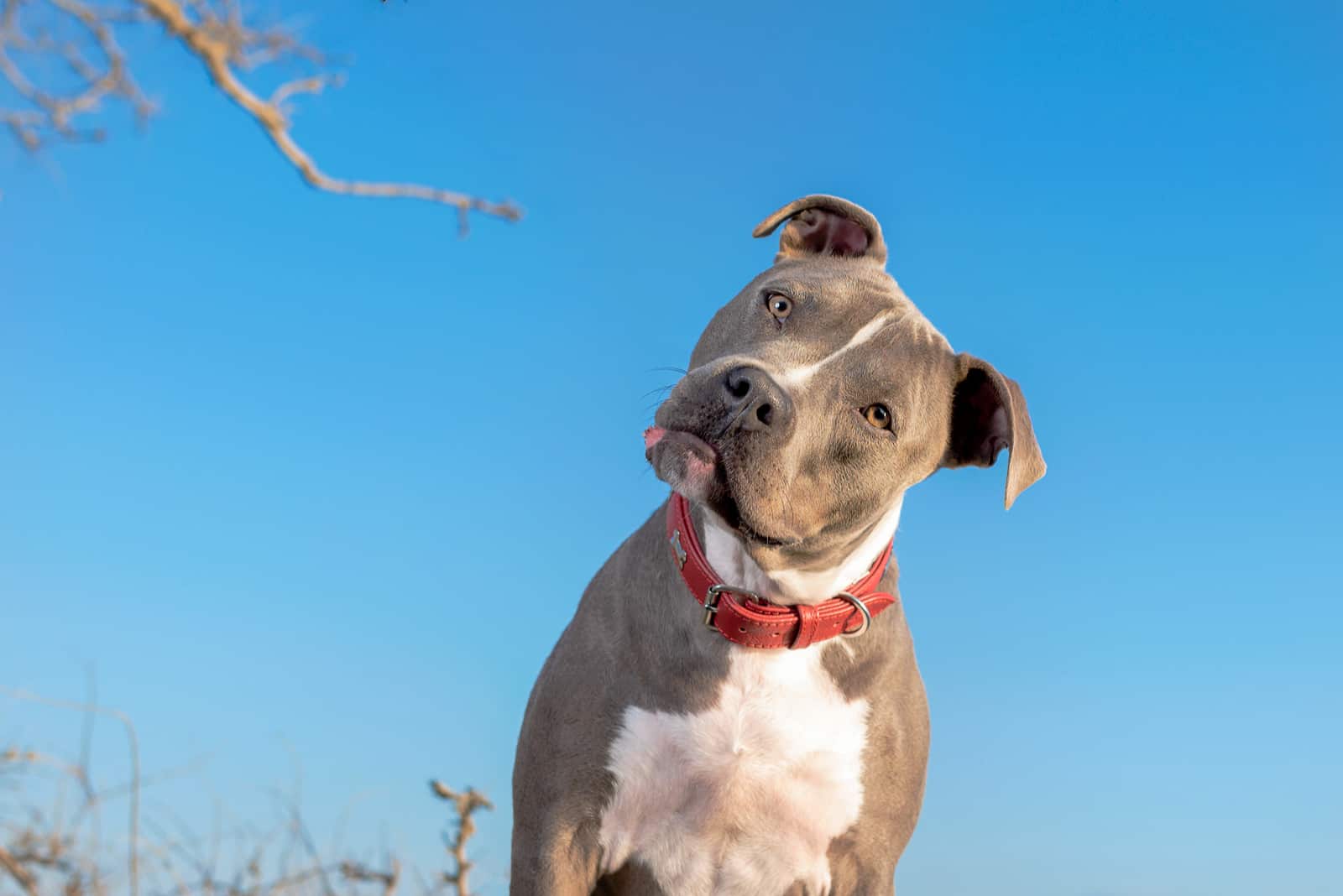
The Pitbull raw diet is a contentious topic among pet owners and veterinary experts alike. It has some clear benefits, but also some potential risks associated with it.
If you are thinking of putting your Pitbull on a fully raw diet, we suggest that you do all the necessary research first. Read some respected studies, talk with experienced raw feeders and veterinary nutritionists, and most importantly, consult your vet.
We hope that this article has shed some light on the topic, and that it will prove to be a great starting point for you whether you decide to introduce your dog to raw food or not.
